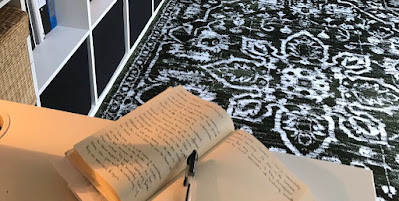I visited the scene of a crime today. I wasn't the only person on the scene. The police were there watching over the cordoned off area. Media were flocking to the scene as fast as they could scramble over rocky pathways, slippery mud and squelching ground. The ups and downs of Hadrian's Wall path took a few of them by surprise but they struggled on gamely in unsuitable footwear for a blustery September day in rural Northumberland. A drone was filming overhead while the people gathered, locals and visitors alike to witness the death of a Sycamore tree.
 |
| Sycamore Gap on Hadrian's Wall 28/09/2023. |
 |
| Sycamore Gap, where the tree waits for Spring, 2023. |
This is a special tree. For a couple of hundred years it has grown and thrived next to Hadrian's Wall. It is famous since it featured in Robin Hood, Prince of Thieves, starring Kevin Costner and Morgan Freeman, and Northumbrians have embraced this tree as almost symbolic of their ability to live and thrive in a wild and beautiful county in the far north of England. This area is a UNESCO World Heritage Site that encompasses the Wall of Roman Emperor Hadrian and its associated structures, forts, ditches, milecastles, turrets, temporary camps, quarries, the towns (also known as vicae outside the forts) and any number of other features in this stunning landscape.
The tree means a lot to locals and visitors alike. It is probably the most photographed tree in the United Kingdom. Proposals of marriage take place beneath its leafy branches on a regular basis and it hosts picnics on a daily basis. Thousands of tourists walk past it every year. It is loved and treasured and now, it is no more.
As I write this post, a 16 year old has been arrested and is helping Northumbrian Police with their inquiries. The Police are keeping an open mind and appealing for more information. But some person, or perhaps there was more than one, marked up the trunk, then took a chainsaw to it, a large one because this is a large tree, and hacked it through the trunk. It fell to the north and landed on the remains of the Roman Wall behind it.
And me? I have loved this tree since the first time I saw it. It has been part of my life for so long. Terrible things happen in the world and are arguably worse than the felling of a tree. However, I mourn this tree because it meant a lot to me. And the person(s) who cut this tree down lack some essential human quality, I think.
Around the fallen giant, people were talking, some whispering, others talking loud, raising their voices above the damp-infested wind blowing in from the south west. Everyone wants to know why but nobody has any answers. I have no answers, only one question. What sort of mind does this?
And I have one wish. I wish that something beautiful could be created from the wood of this Sycamore tree, something to remember its wild majesty and its life which mattered to so many of us before it was destroyed.


